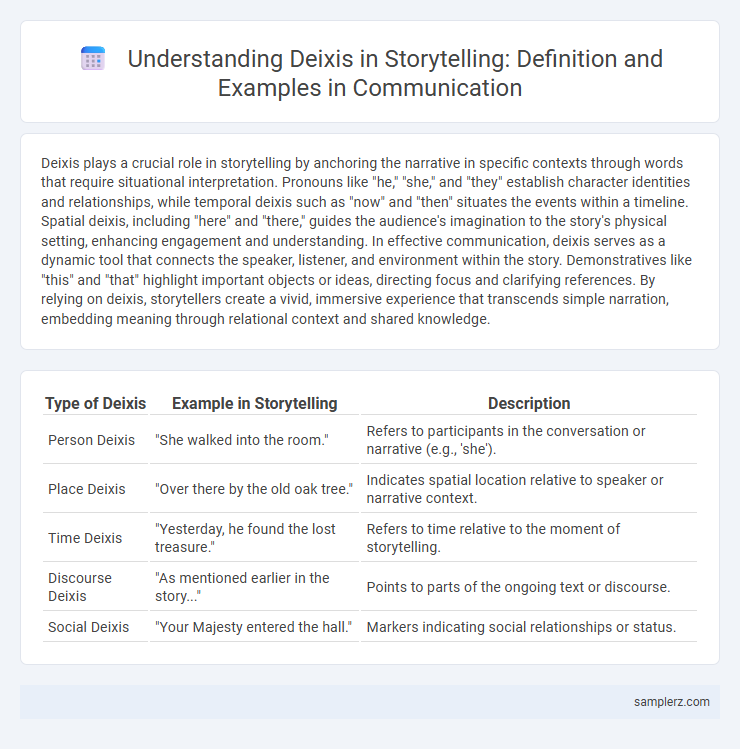Deixis plays a crucial role in storytelling by anchoring the narrative in specific contexts through words that require situational interpretation. Pronouns like "he," "she," and "they" establish character identities and relationships, while temporal deixis such as "now" and "then" situates the events within a timeline. Spatial deixis, including "here" and "there," guides the audience's imagination to the story's physical setting, enhancing engagement and understanding. In effective communication, deixis serves as a dynamic tool that connects the speaker, listener, and environment within the story. Demonstratives like "this" and "that" highlight important objects or ideas, directing focus and clarifying references. By relying on deixis, storytellers create a vivid, immersive experience that transcends simple narration, embedding meaning through relational context and shared knowledge.
Table of Comparison
| Type of Deixis | Example in Storytelling | Description |
|---|---|---|
| Person Deixis | "She walked into the room." | Refers to participants in the conversation or narrative (e.g., 'she'). |
| Place Deixis | "Over there by the old oak tree." | Indicates spatial location relative to speaker or narrative context. |
| Time Deixis | "Yesterday, he found the lost treasure." | Refers to time relative to the moment of storytelling. |
| Discourse Deixis | "As mentioned earlier in the story..." | Points to parts of the ongoing text or discourse. |
| Social Deixis | "Your Majesty entered the hall." | Markers indicating social relationships or status. |
Understanding Deixis: A Key Element in Storytelling
Deixis in storytelling involves using words like "this," "that," "here," and "now" to anchor the narrative in time, space, or person, guiding the audience's interpretation. Understanding deixis enables storytellers to create immersive experiences by situating events relative to the narrator and listener, enhancing clarity and emotional engagement. Effective use of deixis bridges the gap between abstract concepts and concrete moments, making stories relatable and vivid.
Types of Deixis Used in Narratives
In storytelling, deixis commonly includes person deixis, such as "I" and "you," which establishes the narrative perspective and engages the audience directly. Spatial deixis, indicated by words like "here," "there," or "above," situates characters and events within a physical or imagined space. Temporal deixis uses time-related expressions like "now," "then," or "tomorrow" to anchor the narrative timeline and guide the audience through the sequence of events.
Person Deixis: Building Character Perspectives
Person deixis in storytelling centers on the use of pronouns such as "I," "you," and "he/she" to establish character perspectives and convey subjective experiences. These linguistic markers enable narrators to anchor the narrative voice, revealing personal viewpoints and emotional states that deepen character development. By strategically employing person deixis, storytellers create immersive and relatable narratives that emphasize individual identities and relationships.
Place Deixis: Setting the Scene in Stories
Place deixis is crucial in storytelling as it anchors the narrative by specifying locations relative to the speaker or characters, such as "here," "there," or "over there." This spatial referencing helps readers visualize the scene, making the story more immersive and relatable. Effective use of place deixis enhances the setting's clarity and guides audience understanding of the narrative's physical environment.
Time Deixis: Anchoring Events Chronologically
Time deixis in storytelling anchors events chronologically by using temporal expressions such as "yesterday," "now," and "soon" to establish a clear timeline for the audience. These markers help listeners or readers understand the sequence and relative timing of events within the narrative. Effective use of time deixis enhances coherence and engagement by situating actions in a specific chronological context.
Social Deixis: Indicating Relationships in Dialogue
Social deixis in storytelling highlights relationships through language choices like honorifics, titles, or pronouns that signal social hierarchy or familiarity between characters. For example, using "Doctor" versus a first name conveys respect or formality, while shifting from "you" to a nickname signals closeness. These deixis markers enrich dialogue by providing subtle cues about status, intimacy, and social roles within the narrative.
Deictic Words and Their Impact on Story Immersion
Deictic words like "here," "there," "now," and "then" anchor listeners in the spatial and temporal framework of a story, intensifying immersion by creating a vivid mental map. These words direct attention and establish a shared context between the narrator and audience, enhancing engagement and emotional connection. Effective use of deixis in storytelling constructs a dynamic narrative environment, making events more immediate and relatable.
Analyzing Deixis in Famous Literary Excerpts
Deixis in storytelling highlights how words like "here," "now," and "you" anchor narratives in specific contexts, as seen in Shakespeare's "Hamlet," where the word "this" points to immediate emotional states. Analyzing deixis in famous literary excerpts reveals how authors manipulate spatial, temporal, and personal references to engage readers and shape narrative perspective. This technique deepens comprehension of character motivations and enhances immersive storytelling by signaling shifts in time and place within the text.
Strategies for Teaching Deixis Through Storytelling
Effective strategies for teaching deixis through storytelling include using vivid contextual cues and engaging gestures to clarify spatial and temporal references such as "here," "now," and "that." Incorporating role-play and interactive narratives helps learners anchor deictic expressions to real-world contexts, enhancing comprehension and retention. Emphasizing perspective-taking enables students to understand shifting referents based on speaker viewpoint, crucial for mastering deixis in natural communication.
Enhancing Storytelling Skills with Effective Deixis Usage
Using deixis effectively in storytelling anchors the narrative in specific times, places, and perspectives, allowing listeners to vividly visualize scenes through expressions like "here," "there," "this moment," and "that day." Proper deixis usage guides audience attention, clarifies character viewpoints, and enriches emotional engagement by situating events within relatable contexts. Mastering deixis enhances storytelling clarity and immersion, enabling speakers to create more compelling and memorable narratives.

example of deixis in storytelling Infographic
 samplerz.com
samplerz.com